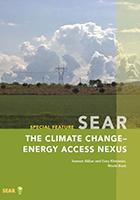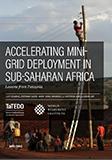Publications
If the world is to have a reasonable chance of preventing global temperatures from increasing beyond 2 degree celcius above pre-industrial levels, net emissions of carbon dioxide (CO2) and other long-lived greenhouse gases (GHGs) must approach zero in the second half of this century. This will have implications for virtually all aspects of the energy system, given the large and dominant role of energy-related emissions in current carbon budget.
On the bright side, emerging linkages between the energy access and climate change agendas offer opportunities to simultaneously bring energy access solutions to scale, achieve mitigation objectives, and create more resilient and sustainable communities. The Paris Agreement’s structure - including contributions from all countries and a technology framework that addresses access and finance for those technologies that shift away from fossil-based infrastructure - is critical for improving resilience and the eventual reduction of GHGs in countries that still lack access to modern fuels. This point has been reinforced by recent World Bank research that shows that very poor, agriculture-focused countries typically do not consume a lot of energy. In fact, in 2011, the 900 million people (13 percent of the population) living in the 50 poorest countries emitted only 0.8 percent of global CO2 emissions, yet they are among the most vulnerable to climate impacts. Energy access goals can provide an important point of entry for mitigation of both long-lived GHGs (like carbon dioxide, methane, and nitrous oxide) and short-lived climate pollutants (SLCPs) (like black carbon, methane, and hydrofluorocarbons).
Akbar, Sameer; Kleinman, Gary. 2017. The Climate Change-Energy Access Nexus. State of Electricity Access Report. Washington, D.C.: World Bank Group. http://documents.worldbank.org/curated/en/465151494924794652/The-climate-change-energy-access-nexus


